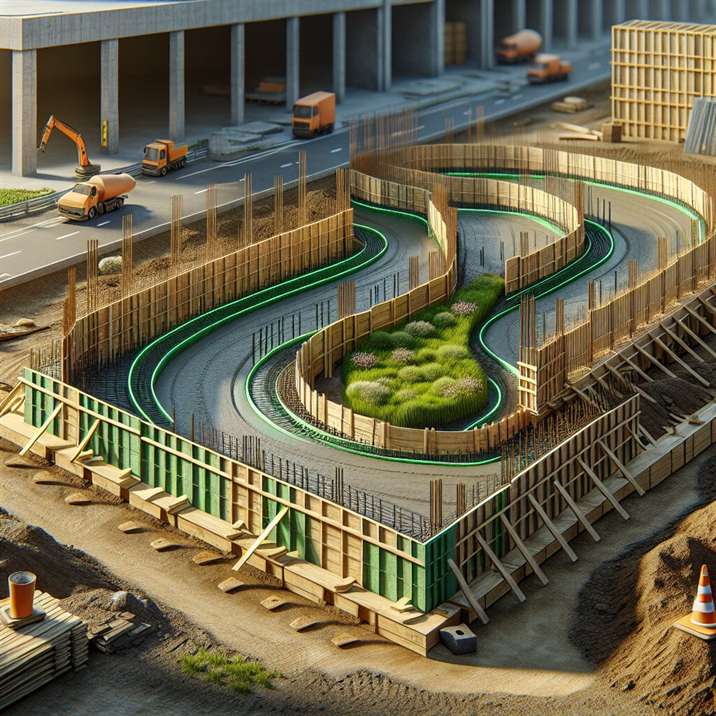Construction Layout Stakes: Step-by-Step Installation Guide
Introduction
Did you know that construction layout stakes are pivotal in ensuring the success of any construction project? These essential tools are used to mark boundaries, guide excavations, and align structures, helping to prevent setbacks, inaccuracies, and inefficiencies. Without them, projects would face significant challenges in staying on track and meeting deadlines.
In modern construction, the importance of construction layout stakes has only grown. As projects become more complex and technology advances, these stakes provide the foundation for precision and accuracy. From residential buildings to large-scale civil engineering projects, they are crucial in ensuring proper alignment and execution. With the rise of innovative materials and techniques, the construction industry is adapting to new methods of utilizing layout stakes to improve project outcomes.
This article will explore the world of construction layout stakes, offering a comprehensive guide that covers their definition, historical context, installation process, benefits, common challenges, and future trends. Whether you’re a seasoned construction professional or a DIY enthusiast, this guide will equip you with the knowledge needed to make informed decisions when using construction layout stakes.
For more insights on construction materials, visit our guide on Impact of Building Materials.
What are Construction Layout Stakes?
Definition
Construction layout stakes are wooden or plastic markers used to outline the layout of a construction site. They help define boundaries, indicate where structures will be built, and guide excavation and grading processes. These stakes are typically installed at key points on a construction site, allowing workers to visualize the project’s layout and make necessary adjustments.
Historical Context
The use of stakes in construction can be traced back to ancient civilizations. Initially, builders relied on simple wooden stakes to mark their sites, but as construction techniques evolved, so did the materials and methods used for layout. Historic landmarks, such as the Great Pyramids of Giza, illustrate the importance of precise layout in construction. Over time, the introduction of modern surveying tools and technology has enhanced the efficiency and accuracy of using layout stakes.
The Importance of Construction Layout Stakes
In today’s construction landscape, the relevance of construction layout stakes cannot be overstated. As projects grow in scale and complexity, the need for accurate site layout becomes paramount. Layout stakes serve as the primary reference points for contractors, ensuring that structures are built in the correct location and orientation. This accuracy helps prevent costly mistakes, reduces material waste, and improves overall project efficiency.
Construction Layout Stakes in the Context of Civil Engineering
In civil engineering, construction layout stakes play a vital role in projects such as road construction, bridge building, and land development. They help engineers and contractors align their work with design specifications, ensuring that every element of the project is executed as planned. Accurate layout is critical in civil engineering, where even minor errors can lead to significant structural issues.
Key Players or Contributors
Several organizations have contributed to the advancement of construction layout stakes, including manufacturers of surveying equipment and materials. Innovations in stake materials, such as eco-friendly options and treated wood products, have emerged to meet the growing demand for sustainable construction practices. As the industry continues to evolve, these innovations will play a crucial role in shaping the future of construction layout.
For a comprehensive overview of construction tools, check out our article on essential tools for construction.

How Does Construction Layout Stakes Work?
The Mechanics of Construction Layout Stakes
The installation and use of construction layout stakes involve several key steps:
- Site Assessment: Before installation, a thorough assessment of the construction site is necessary. This includes understanding the project specifications, reviewing design plans, and identifying any potential obstacles.
- Mark the Corners: Begin by marking the corners of the intended structure using spray paint or flags. These initial markers will serve as the reference points for installing the layout stakes.
- Installing the Stakes: Using a sledgehammer or mallet, drive the stakes into the ground at the marked points. Ensure that the stakes are positioned vertically and aligned with the project plans.
- String Lines: After the stakes are in place, attach string lines between them. This provides a visual guide for ensuring that subsequent construction elements are aligned correctly.
- Double-Check Measurements: Use a measuring tape to verify that the distances between stakes correspond to the project specifications. Making adjustments at this stage can save significant time and resources later on.
Technological Foundations of Construction Layout Stakes
The effectiveness of construction layout stakes is significantly enhanced by modern technology. Tools such as GPS and laser levels are increasingly used in conjunction with traditional stakes to achieve greater accuracy. These technologies allow for real-time monitoring of layout plans, reducing the chances of human error and ensuring that construction aligns perfectly with design specifications.
Real-World Applications of Construction Layout Stakes
Construction layout stakes are utilized across a variety of projects, from residential homes to large-scale commercial developments. For instance, in a residential project, stakes are used to outline the foundation’s footprint, ensuring that the excavation crew knows where to dig. In commercial developments, layout stakes guide the construction of parking lots, roadways, and other critical infrastructure.
Case Studies/Examples of Construction Layout Stakes in Action
- Residential Housing Development: In a recent housing development, contractors used construction layout stakes to mark the foundation locations for multiple homes. By following the stakes closely, they were able to complete the excavation and foundation work with minimal errors, saving time and resources.
- Bridge Construction: During the construction of a new bridge, layout stakes were critical in ensuring that the alignment of the bridge’s supports matched the engineering specifications. Any misalignment could have resulted in structural complications, emphasizing the stakes’ importance in civil engineering.
Benefits of Using Construction Layout Stakes
Using construction layout stakes offers several advantages, including:
- Accuracy: Layout stakes provide precise reference points that help ensure all measurements and alignments are correct, reducing the potential for costly mistakes.
- Efficiency: By clearly marking boundaries and layout lines, construction workers can proceed with confidence, leading to faster project completion times.
- Cost-Effectiveness: Accurate layout reduces material waste, as fewer errors mean less rework. This can lead to significant savings on materials and labor.
- Enhanced Communication: Construction layout stakes serve as visual guides for all team members, which improves communication on the job site. Everyone can quickly understand the layout and make informed decisions.
- Versatility: Construction layout stakes can be used in various projects, from residential buildings to large-scale civil works, making them an essential tool for any construction professional.
Common Challenges in Using Construction Layout Stakes
While construction layout stakes are invaluable tools, they do come with challenges that professionals must navigate:
- Weather Conditions: Rain, snow, or high winds can affect the stability and visibility of layout stakes. Contractors need to be mindful of weather forecasts and plan accordingly.
- Ground Conditions: Hard or rocky soil can make it difficult to drive stakes into the ground, necessitating the use of specialized tools or techniques.
- Site Changes: Changes in project plans or unexpected site conditions may require the repositioning of layout stakes, which can be time-consuming.
Future Trends in Construction Layout Stakes
The future of construction layout stakes is likely to be shaped by advancements in technology and sustainable practices. Here are some trends to watch for:
- Smart Stakes: The integration of smart technology, such as sensors or GPS, could transform layout stakes into dynamic tools that provide real-time data on position and alignment.
- Sustainable Materials: As the construction industry moves towards more eco-friendly practices, the demand for sustainable materials in layout stakes will increase. Innovations in biodegradable or recycled materials could become more prevalent.
- Automation: The use of drones and robotics for site layout is on the rise, potentially reducing the need for traditional stakes in some applications. However, stakes are likely to remain a staple due to their simplicity and effectiveness.
Conclusion
Construction layout stakes are essential tools that facilitate accuracy, efficiency, and clear communication in construction projects. Understanding their definition, historical context, and practical application is crucial for anyone involved in the industry. As technology advances and the demand for sustainable practices grows, the evolution of construction layout stakes will continue to play a significant role in shaping the future of construction.
For a deeper understanding of how to maximize the effectiveness of construction layout stakes, be sure to explore our guide on Optimal Site Grading Stakes Placement. This knowledge will empower you to tackle any project with confidence, ensuring that your construction endeavors are both successful and efficient.
Resource Links:
1. National Geographic – Overview of construction layout stakes and their significance in building projects.
2. Construction Dive – Step-by-step guide on the installation and use of construction layout stakes.
3. FMLink – Detailed instructions and best practices for using layout stakes in construction.

